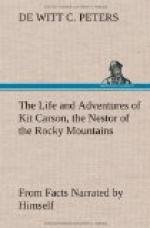In the early spring of 1845, Kit Carson, after weighing the various occupations which presented, decided to become a farmer. One of his mountaineer friends, Mr. Richard Owens, came to the same conclusion. Together they talked over their plans, and concluded that it would be to them, at least, newness of life to be domiciled in their own houses. The two hunters carefully marked out their plans, and then set to work with a will for success to carry them into execution. A very short time enabled them to choose a farming site, because their knowledge of the country enabled them to see all of its desirable localities, as it were at a glance. They decided to purchase a tract of wild land situated on the little Cimeron River, and improve it. Their arrangements were soon made, tools and implements, stock and animals, provisions and necessaries all procured. With the services of some laborers hired by them, they were soon engaged actively preparing their land for the reception of seed. The spot which they selected was forty-five miles east of Taos. They commenced the enterprise by building some small huts. These afforded both themselves and their Mexican laborers a comfortable lodgment. They sowed a considerable quantity of grain, and prepared timber almost sufficient to build good substantial houses. Their vigorously prosecuted labors began to show evident results, and in the prospect, it was clearly apparent that another year would serve to give them profitable reward for their enterprise.
It seems appropriate at this point, that we should enable the reader to look upon and judge of the farming country and habits of New Mexico; their markets, and some of the manners and customs of the people who dwell in cities. The town of Taos affords a fair sample of the markets, and as Kit Carson has many times been exhibited to the reader at that place, it is very proper that we should describe it.
The town of Taos is located in a valley called by the same name. The town consists of a series of villages, which are scattered, and are known to the Mexicans by various names. The main village is called Fernandez de Taos, and is located near the centre of the valley, on a high plateau of ground. The buildings here, as, indeed, in all the towns of New Mexico, are constructed of adobes, and are one story high, with what is usually known as flat roofs. These houses are huddled together without much regard being paid to streets. The main attraction of the town is the plaza, where all the business, such as marketing, etc., is carried on. It is here that the stores are located; and, on a fete day, or in business hours, it is thronged with Mexicans, Americans, and Indians. Among these there is a large per-centage of idlers. The houses are mostly covered with a white material, which is either chalk or lime. The church is the largest building in the town, and is a rough specimen of architecture, which is rudely finished within. It has a flat-sounding




